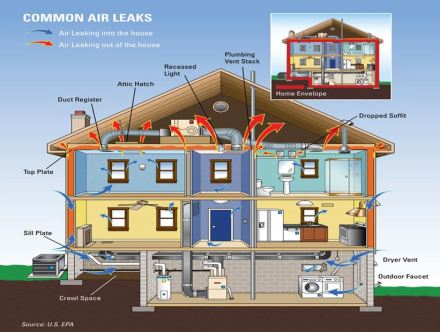During the month of January, I’ve been called to diagnose roof leaks on an almost daily basis. These leaks have a common characteristic – they show up when it’s cold. That usually signals that there is some form of accumulation of water on the roof, usually behind an ice dam, and that the waterproofing is insufficient to stop the water from forcing its way it. The existence of an ice-dam almost always means that there is excessive transfer of heat to the roof which melts the snow on the upper sections, and the resulting meltwater refreezes on the lower section over the soffits. To reduce this heat transfer, we rely on insulation (to reduce the amount of heat leaking into the attic) and ventilation (to dissipate the residual heat before it melts the snow on the roof). However, there is another player in this game, and it can cancel out the efforts at insulating and ventilating. That player is air leakage.
The Stack Effect
Hot air rises. That’s why hot-air balloons have a big “hole” at the bottom, and still manage to stay aloft. That also what you need to ensure that smoke from your fireplace goes up the chimney, instead of into your home.
But hot air can also create some pressure, and when that pressure hits the openings in your ceiling, the hot air pushes though those openings. Cold air from the outside replaces the hot air escaping, usually somewhere along a space low in the building. The overall effect looks like this:

Image source: https://www.epa.gov/
When air enter the attic (or other cold spaces), it reduces the ability of insulation to resist heat transfer (due to convection), and increases the possibility of condensation which in turn reduces the insulation value of the insulation. This condensation, if not dried out via attic ventilation, can contribute to mold, wood rot, and interior damage.
Typical places where air can enter include the openings in the ceiling are air ducts, pot lights, plumbing vents, bathroom and kitchen vents, light and electric fixtures, and incomplete finishing around the wall/ceiling perimeter.
The taller the building, the stronger is the stack effect pressure.
By some estimates, up to 40% of the heat loss in the roof is caused by such openings. Adding insulation over such leaky ceilings will contribute minimally to lowering the heat loss. Therefore, if it appears you have enough insulation to reach at least R40 in your attic, looking for air leakage through the various openings in the ceiling may be the starting point in locating the problem areas.
Heat transfer and leaks
The heat transferred to the attic can be dissipated if there is enough ventilation. If the transfer is too great, the passive ventilation may not be able to dissipate the heat enough to prevent the decking from heating up. At this point, the heat building up along the upper reaches of the attic will start to melt the snow that is on the roof, and this melt-water now runs down the roof towards the eaves. If there are weaknesses in the waterproofing under the roof covering, this can show up as a leak. Usually, the water will run to the eaves and start to freeze over the soffit cavity, forming an ice dam. Once enough water has accumulated behind the ice dam, the water is now under pressure, and enters the attic if the waterproofing is inadequate or insufficient.
Summary:
Lack of air sealing can have the following effects:
- Increased heating costs,
- Increased entry of warm, moist air into the cold spaces, contributing to condensation.
- The condensation, if not dissipated by ventilation, can contribute to wood rot, plywood delamination, OSB degredation, gyproc damage, mold growth, and support carpenter ants.
- Heat loss to the attic, if not dissipated by ventilation, can contribute to formation of ice dams, and their attendant problems.
In a future post, I will show how air infiltration shows up in a “cold” attic.
(c) 2017 Paul Grizenko

Pingback: Ice Dams – a look at remediation | PRS Consulting